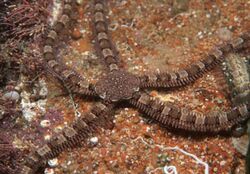Biology:Ophionereis schayeri
| Ophionereis schayeri | |
|---|---|

| |
| Scientific classification | |
| Domain: | Eukaryota |
| Kingdom: | Animalia |
| Phylum: | Echinodermata |
| Class: | Ophiuroidea |
| Order: | Ophiurida |
| Family: | Ophionereididae |
| Genus: | Ophionereis |
| Species: | O. schayeri
|
| Binomial name | |
| Ophionereis schayeri Müller & Troschel 1844
| |
Ophionereis schayeri, Schayer's brittle star, is a brittle star in the family Ophionereididae.
Description
The central disk is up to 2.5 centimetres wide, with arms to 15 centimetres long. The species is a filter-feeder that sifts sand and mud from the ocean floor for detritus and plankton.[citation needed]
Habitat and distribution
Schayer's Brittle Star is found off the coast of Australia. Areas include New South Wales, Victoria, South Australia, Western Australia and Tasmania. It is the largest and most common brittle star found near Sydney.[citation needed]
The species occurs from the inter-tidal zone to 180 metres below sea level. This brittle star may be found under boulders in tidal areas. It moves quickly away from light when exposed. To reduce exposure to high temperatures, O. schayeri will form clusters under boulders in rocky reef habitats. Under these boulders, they scavenge for food by extending their arms out at night.[1][2][3][4] Like many species inhabiting tide pools, O. schayeri may be particularly susceptible to the increased temperatures and ocean acidification engendered by climate change.[5]
Life cycle
As all brittle stars, Schayer’s brittle star undergoes a process of metamorphoses throughout their life cycle, starting from planktotrophy and moving to brooded lecithotrophy. The larva of a Schayer’s brittle star is bilaterally symmetrical, with a ciliated band around the body. The next developmental form is a vitellaria larva, bordered by ciliary ridges. The vitellaria larva soon develops juvenile tube feet and ventral skeletal plates. This metamorphosis results in a full body transformation from bilateral to radial symmetrical form, the last of which resembles other members of the Echinodermata phylum. (Selvakumaraswamy & Byrne, 2004).[6] This evolutionary adaptation from planktotrophic to lecithotrophic development can be associated with an increased maternal reliance. The lecithotrophic development evolved along with a larger egg. Both of these evolutionary adaptations led to an increase in triglyceride present in the eggs. The effect of this increase in triglyceride levels on the eggs is still currently undergoing research (Inke et al, 2006).[7]
Bioluminescence
Similar to the related species O. fasciata, Schayer's brittle star is capable of bioluminescence, which may function as a warning to predators. It is hypothesized that this behavioral phenomenon requires extra-cellular calcium, associating with the radial nerve chord in order to trigger the luminescence. The fluorescent cells are photocytes, which can be found under the ventral, dorsal, and lateral arm plates. The true functional purpose of this bioluminescence has yet to be studied.[8]
References
- ↑ Christensen, Ana B.; Nguyen, Hong D.; Byrne, Maria (2011). "Thermotolerance and the effects of hypercapnia on the metabolic rate of the ophiuroid Ophionereis schayeri: Inferences for survivorship in a changing ocean". Journal of Experimental Marine Biology and Ecology 403 (1–2): 31–38. doi:10.1016/j.jembe.2011.04.002. https://www.academia.edu/24671331.
- ↑ "Ophionereis schayeri". The Atlas of Living Australia. https://bie.ala.org.au/species/urn:lsid:biodiversity.org.au:afd.taxon:1856e0e5-98e0-4448-9dc0-6f2b0091721c. Retrieved 7 August 2019.
- ↑ "Ophionereis schayeri". The Australian Museum. https://australianmuseum.net.au/learn/animals/sea-stars/schayers-brittle-star/. Retrieved 7 August 2019.
- ↑ "Ophionereis reticulata". Museums Victoria Collections. https://collections.museumvictoria.com.au/species/8642. Retrieved 7 August 2019.
- ↑ Christensen, Ana B.; Nguyen, Hong D.; Byrne, Maria (2011-07-15). "Thermotolerance and the effects of hypercapnia on the metabolic rate of the ophiuroid Ophionereis schayeri: Inferences for survivorship in a changing ocean" (in en). Journal of Experimental Marine Biology and Ecology 403 (1): 31–38. doi:10.1016/j.jembe.2011.04.002. ISSN 0022-0981. https://www.sciencedirect.com/science/article/pii/S0022098111001341.
- ↑ Selvakumaraswamy, P; Byrne, M (2000-06-01). "Vestigial ophiopluteal structures in the lecithotrophic larvae of Ophionereis schayeri (Ophiuroidea)". The Biological Bulletin 198 (3): 379–386. doi:10.2307/1542693. ISSN 0006-3185. PMID 10897451. https://www.journals.uchicago.edu/doi/10.2307/1542693.
- ↑ Falkner, Inke; Byrne, Maria; Sewell, Mary A. (2006-12-01). "Maternal Provisioning in Ophionereis fasciata and O. schayeri: Brittle Stars With Contrasting Modes of Development". The Biological Bulletin 211 (3): 204–207. doi:10.2307/4134542. ISSN 0006-3185. PMID 17179379. https://www.journals.uchicago.edu/doi/10.2307/4134542.
- ↑ Thomas., Heinzeller (2005). Echinoderms: München proceedings of the 11th International Echinoderm Conference, Munich, Germany, 6-10 October 2003. Taylor & Francis. ISBN 0-415-36481-7. OCLC 890667816. http://worldcat.org/oclc/890667816.
Wikidata ☰ Q1963770 entry


